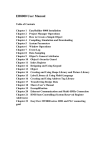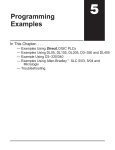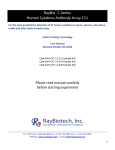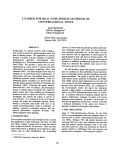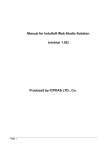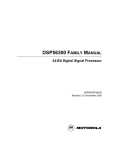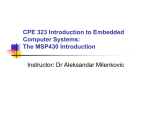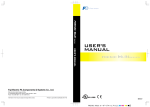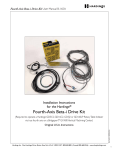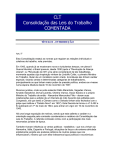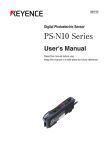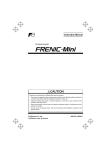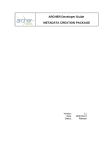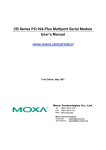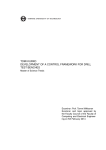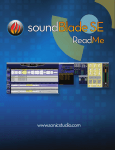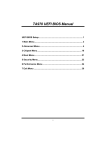Download Chapter 10 DMA Controller
Transcript
Chapter 10 DMA Controller Direct Memory Access (DMA) is one of several methods for coordinating the timing of data transfers between an input/output (I/O) device and the core processing unit or memory in a computer. DMA is one of the faster types of synchronization mechanisms, generally providing significant improvement over interrupts, in terms of both latency and throughput. An I/O device often operates at a much slower speed than the core.1 DMA allows the I/O device to access the memory directly, without using the core. DMA can lead to a significant improvement in performance because data movement is one of the most common operations performed in processing applications. There are several advantages of using DMA, rather than the core, in the DSP56300 family: ■ DMA saves core MIPS because the core can operate in parallel. ■ DMA saves power because it requires less circuitry than the core to move data. ■ DMA saves pointers because core AGU pointer registers are not needed. ■ DMA has no modulo block size restrictions, unlike the core AGU. Traditionally, DMA uses the same internal address and data buses as the core. Consequently, when DMA performs one or more word transfers, it can cause the core to temporarily halt activity for one or more cycles while DMA moves the data. With this type of architecture, the core and DMA cannot both perform data moves in the same core clock cycle. To overcome data movement restrictions imposed by sharing resources with the core, the DMA system in the DSP56300 family contains its own dedicated internal address and data buses. Internal memory is partitioned so that the Program Control Unit (PCU) and DMA can both perform internal memory accesses in the same core clock cycle, as long they are accessing different memory partitions. Also, if one of these two controllers (PCU or DMA) is accessing internal memory, the other controller can perform an external memory access in the same core clock cycle. 1. The term “core” has a special meaning when described in the context of DMA. Technically, the DSP56300 core contains all of the circuitry that is common to all devices in the DSP56300 family, including the DMA controller and buses. However, when described in the context of DMA, the core actions referred to are those caused by data movement instructions executed by the PCU, not data movement performed by DMA. Motorola DSP56300 Family Manual 10-1 In addition to data moves between I/O and internal or external memory, the DMA in the DSP56300 can perform memory-to-memory transfers (internal, external, or mixed). Table 10-1 summarizes by source/destination type the various types of data transfers that the DMA Controller can perform. Table 10-1 DMA Controller Data Transfers Clock Cycles per Single Word Transfer1 Type of Transfer Internal Memory → Internal Memory 2 External Memory ↔ Internal Memory 2 + wait states External Memory → External Memory2 2 + wait states Internal Memory ↔ Internal I/O 2 External Memory ↔ Internal I/O 2 + wait states Internal I/O → Internal I/O 2 NOTES: 1. Data transfer for one channel takes a minimum of two clock cycles per single word. 2. External memory includes external I/O. The DMA unit contains the necessary counters, offset registers, and pointers to transparently handle one-, two-, and three-dimensional data matrix transfers. These registers can be given values that result in special addressing modes, for example, access to circular buffers and linear buffers with non-unit stride. The data structure dimensionality can be chosen independently for the source access versus the destination access involved in the data move. The DSP56300 contains six DMA channels that share buses and offset registers but are otherwise independent. Each DMA channel can be triggered by interrupt pins, peripheral actions, or other DMA events, and assigned a priority relative to other channels and relative to the core. Each of the six DMA channels contains its own set of four operational registers, all of which are memory-mapped in the internal I/O memory space and all of which are 24-bit registers: ■ DMA Source Address Register (DSR): A read/write register that contains the source address for the next DMA transfer for its channel. Each DMA channel has one DSR: DSR0, DSR1, DSR2, DSR3, DSR4 and DSR5. ■ DMA Destination Address Register (DDR): A read/write register that contains the destination address for the next DMA transfer for its channel. Each DMA channel has one DDR: DDR0, DDR1, DDR2, DDR3, DDR4 and DDR5. ■ DMA Counter (DCO): A read/write register that contains the number of DMA data transfers to be performed by its channel. The DCO has five modes of operation determined by the DMA channel Address Generation mode defined in the DMA channel’s Control Register. Each DMA channel has one DCO: DCO0, DCO1, DCO2, DCO3, DCO4 and DCO5. 10-2 DSP56300 Family Manual Motorola DMA Operational Overview ■ DMA Control Register (DCR): A read/write register that controls the operation of a DMA channel. Each DMA channel has one DCR: DCR0, DCR1, DCR2, DCR3, DCR4 and DCR5. The DMA Controller also has supporting 24-bit registers available to all the DMA channels: ■ DMA Offset Register (DOR): Each DOR is a read/write register that contains the offset value to be used in some of the DMA addressing modes. The DMA controller has four common offset registers (DOR0, DOR1, DOR2 and DOR3) that can be used by all the channels according to their Address Generation mode. ■ DMA Status Register (DSTR): This read-only register reflects the overall operating status of all channels in the DMA Controller. In summary, the DSP56300 DMA can perform I/O and memory accesses that are independent of and frequently simultaneous with PCU operations. DMA can transfer memory-to-memory and handle mixed multi-dimensional and special address mode transfers. DMA contains six highly independent channels with separate priorities and multiple trigger choices. These capabilities significantly enhance code performance. 10.1 DMA Operational Overview The following subsections describe how the DSP56300 DMA operates. These subsections are organized by function, rather than by event sequence. The DMA register description section contains detailed operational information. 10.1.1 Basic Address Modes The DSP56300 DMA can deal with the following basic types of data structures: ■ Constant Addressing: This mode uses a single address throughout the data transfer. Typically this is used by I/O devices that use a single address to transfer information. ■ One-dimensional: A one-dimensional matrix consisting of one item or a “line” of items located in consecutive memory locations. ■ Two-dimensional: A two-dimensional matrix or table that is stored in row-column order with equal spacing in memory between each row or line. ■ Three-dimensional: A three-dimensional matrix or collection of tables that are equally spaced in memory. The type of data structure is specified in the counter mode for the DMA channel. The counter mode divides a given 24-bit counter register into one or more sections, one for Motorola DMA Controller 10-3 DMA Operational Overview each dimension used. The appropriate counter fields either decrement or reload each time the DMA transfers a data word. A counter field is reloaded with its initial value after that field is decremented to zero. For details on counter operation, see Section 10.5.3, "DMA Counters (DCO[5 – 0])," on page 10-11. Once all fields in the counter are exhausted, one or more data moves are performed and all words, lines, and tables are transferred. The total collection of data moved is called the “block.” Exhaustion of the entire counter results in a single “block transfer.” The automatic counter register updates are directly performed on the user-visible counter register. In other words, the counter register is used for both the count load/reload function and the count decrement function. 10.1.2 Special Address Modes The counter and offset registers can be loaded with special values to produce variants of the basic addressing modes. Some examples covered in more detail in later sections include: ■ Circular buffer: Use a two-dimensional counter and a negative offset that wraps back to the buffer start address. ■ Linear buffer with non-unit stride: Use a two-dimensional counter with one word per row. This method must be used with byte packing, which has a stride of three. ■ A larger-than-normal field width in a two-dimensional counter: Concatenate two fields in a three-dimensional counter by specifying an offset value of one between them. 10.1.3 Unmatched Source and Destination Dimensions The source and destination data structures can have different dimensions.2 The data structure with the largest dimension is read or written once during the block transfer; the data structure with the smaller dimension can be written or read repeatedly. For this situation, a single counter register handles both sides of the transfer. The high-dimension (three-dimensional or two-dimensional) side of the transfer determines the counter mode and thus the number of available counter fields. Each “tick” of the counter counts one word transfer; that is, one source read and one destination write. The data structure on the low-dimension side of the transfer is fully described by a right-justified subset of the counter—the number of counter fields being the same as its dimension (two-dimensional or one-dimensional). This data structure access is repeated (using the exact same addressing sequence) the number of times specified by the upper 2. For an example, see the Motorola application report, APR/23, Using the DSP56300 Direct Memory Access Controller. 10-4 DSP56300 Family Manual Motorola DMA Operational Overview field(s) of the counter. The pointer wraparound back to the beginning of this data structure is accomplished using a negative offset register value, similar to a circular buffer. 10.1.4 DMA Triggers (Request Sources) Data movement in by a particular DMA channel is initiated by either a hardware or a software trigger. Following is an example list of some of the hardware and software DMA triggers, also known as DMA request sources. Peripheral triggers are device-dependent. A DMA channel can be configured for triggering by only one source at a time. ■ Hardware triggers — External interrupt pins (IRQA - IRQD) — DMA channel block transfer completion (by this or a different DMA channel) — Peripheral status bits — Receiver has new datum to be read by DMA — Transmitter needs new datum from DMA to send — Timer compare event ■ Software triggers — DMA Enable bit for this DMA channel A peripheral status bit that triggers an enabled DMA transfer also typically can trigger an enabled peripheral interrupt. The DMA transfer is triggered by the status bit change, not by the peripheral interrupt event, and the DMA transfer occurs whether or not the peripheral interrupt is enabled. Furthermore, avoid triggering a DMA transfer and a peripheral interrupt from the same event; this can result in a lack of coordination regarding resources and status bit changes. 10.1.5 Transfer Mode When a DMA channel is enabled and receives a trigger from its configured trigger source, it begins moving data as soon as the needed resources become available (for example, internal DMA buses and memory locations). As a result of the trigger event, the channel transfers either all or a subset of the block (this is configurable). The amount of data that is transferred in response to each trigger event is determined by the DMA transfer mode. Besides the trigger data structure, the transfer mode also selects either a hardware or software trigger, and automatic block repeat enable. The available transfer modes are single word, line, and block. Typically, a DMA channel used in conjunction with a peripheral operates in a single word transfer mode (triggered by a receiver full or transmitter empty condition). Motorola DMA Controller 10-5 Timing (Core Clock Cycles) 10.2 Timing (Core Clock Cycles) This section describes the timing of core and DMA data transfers in the context of integral core clock cycle counts. When the needed resources are available, each word transfer performed by the DMA takes at least two core clock cycles: ■ Source read (at least one cycle) ■ Destination write (at least one cycle) Any wait states incurred during external memory accesses are added to the DMA word transfer time (for external source and/or destination). Some peripherals (generally those using first-in-first-out (FIFO) for data transfer) may act as “fast DMA request sources.” These peripherals can trigger a new DMA request as often as every two core clock cycles, thereby using the DMA at its maximum throughput rate with zero overhead time. 10.2.1 Non-Overlap Between DMA Channels Data movement can never be performed by more than one DMA channel within a given core clock cycle. For example, it is not possible for Channel 1 to commence its source read before Channel 0 completes its destination write. This non-overlap limitation exists for all situations, including the following cases: ■ One channel needs to read (write) from external memory, and another channel needs to write (read) to internal memory. ■ One of the DMA channels is waiting on the Bus Interface Unit (BIU) for an external access to complete, and the BIU is in turn waiting because of: — Static wait states (determined by Bus Control Register) — Dynamic wait states (controlled by TA pin) — Byte packing This limitation is necessary because there is only one internal DMA address bus and one internal DMA data bus. The internal DMA buses are in use by a DMA channel even during the external memory access phase of the DMA word transfer. Although channel overlap during DMA channel transfers cannot exist, zero overhead between two DMA channel transfers can exist. Once the word transfer performed by a DMA channel is completed, another DMA channel can begin data movement in the very next core clock cycle—if the second DMA channel has already been triggered and is not being delayed by contention or priority issues. 10-6 DSP56300 Family Manual Motorola Channel Priority 10.2.2 Overlap between DMA Channel and Core Since the core and DMA use separate address and data buses, both can perform data movement in a given core clock cycle. This overlap of data movement can occur for the following cases: ■ The core is accessing internal memory while DMA is accessing a different internal memory partition: — RAM: 1/4 Kword partition size (this size is device-dependent) — ROM: 2, 3, or 4 Kword device-specific partition size If the core and DMA try to access the same internal memory partition, the core has priority and DMA is delayed. ■ The core is accessing internal (external) memory while DMA is accessing external (internal) memory 10.3 Channel Priority DMA channel priority determines if and when a DMA channel can be interrupted during a block transfer. An interruption occurs between word transfers. The current DMA word transfer is allowed to complete before the core or another DMA channel can take control of the resource that is under contention. The DMA channel priority arbitration occurs for each DMA word transfer; only enabled and already triggered channels can take part in this arbitration. 10.3.1 Priority Between DMA Channels Each DMA channel can be independently assigned one of four possible priority levels. The treatment of priorities is as follows: ■ Channels with different priorities A higher-priority DMA channel can interrupt a lower-priority DMA channel and complete its block transfer before control transfers back to the lower-priority channel. ■ Channels with the same priority, one of two different modes can be selected: — Continuous mode: A DMA channel cannot interrupt another DMA channel of the same priority. — Non-continuous mode: Control is transferred in a round-robin fashion between each channel of the same priority. Each channel transfers one word before control transfers to the next channel in this group. Motorola DMA Controller 10-7 Channel Priority DMA channels cannot interrupt each other in the middle of word transfers, regardless of their relative priorities. A word transfer made by one DMA channel must finish before another DMA channel can commence a word transfer. 10.3.2 Priority Between a DMA Channel and the Core If the core and a DMA channel are both contending for the same partition of internal memory, but neither has begun the word transfer, the core always takes precedence. The DMA channel must wait until the core is not accessing this memory partition for at least one core clock cycle before it can begin to access the partition. If the DMA channel and the core are each attempting to access a different internal memory partition in RAM or ROM, no contention exists. In this case, the accesses can be made simultaneously (data movement can occur in both of these data paths in a given core clock cycle). If the core and a DMA channel are both contending to make an external memory access, the prioritizing between that channel and the core is performed according to one of two selectable modes: ■ Static DMA/Core Prioritizing mode — The core priority is configured to have a constant fixed relationship with the DMA priority, regardless of which DMA channel is considered. The core priority is set to be either lower, equal, or greater than that of the DMA. The individual DMA channels have equal priority when compared to the core, although they may still have unequal priorities when compared to each other. This mode is set using bits CDP[1 – 0] of the Operating Mode Register. ■ Dynamic DMA/Core Prioritizing mode — The priority of each DMA channel is individually compared with that of the core. The DMA channel priority setting used for comparison with other DMA channels is also used for comparison with the core. This mode is set using bits CP[1 – 0] of the Status Register. Note: Even though DMA and the core have separate address and data buses, there is only one external address and data bus. The core cannot interrupt a DMA channel in the middle of a word transfer to or from a contended resource (an internal memory partition, or external memory), regardless of the core/DMA relative priority. If the DMA channel is already performing an access to the resource, the core must wait until the current DMA word transfer finishes accessing the resource before the core can access that resource. The core may have to wait for the entire DMA word transfer to complete, or it may have to wait only for the DMA source read to complete. This depends on the destination address of the DMA channel. If the destination of the DMA word transfer is not in the contended resource, then the core can proceed with its access to the resource while the DMA performs its destination write somewhere else. 10-8 DSP56300 Family Manual Motorola Special Uses of DMA With the Bus Interface Unit 10.4 Special Uses of DMA With the Bus Interface Unit The following subsections describe Bus Interface Unit (BIU) operations that can only be performed using DMA. 10.4.1 Byte Packing Byte packing is used when the 24-bit data width DSP core interfaces with an 8-bit wide external memory device. Byte packing can be performed only in conjunction with a DMA data move.3 When the DMA channel attempts to read a word from the external memory, it expects a 24-bit value. In accordance with the DMA read, the BIU reads three consecutive bytes from the memory, packs them into one 24-bit word, and then passes this word to the DMA. A reverse sequence occurs for a DMA write to the external memory. The BIU takes the 24-bit word from the DMA channel, unpacks it, and writes it as three consecutive bytes, to the external memory. For both read and write, the DMA views each 24-bit word transfer as a single external access. However, the byte packing operation is not completely transparent to the DMA. To read or write several 24-bit words to or from consecutive locations in the 8-bit memory, the DMA must be programmed to either increase or decrease its external memory address pointer by three for each 24-bit transfer. 10.4.1.1 DRAM In-Page Accesses using DMA When a DMA channel handles several consecutive in-page DRAM word accesses, a special situation can occur if an in-page access is interrupted by an external memory access initiated either by the core or a different DMA channel. The interrupting operation could be a higher-priority access to external SRAM. After the interrupting operation uses the BIU, the original DMA channel can resume reading or writing the DRAM without losing in-page access. This can occur as long as all in-page access conditions (described in Chapter 9, External Memory Interface (Port A)) remain satisfied. 10.4.1.2 End-of-Block-Transfer Interrupt Upon completion of a block transfer by a DMA channel, an optional end-of-block-transfer DMA interrupt can be generated. The interrupt service routine (ISR) called by such an interrupt can perform any functions needed at this time. For example, the ISR could reconfigure the DMA channel for the next data block transfer or restart the DMA channel (if it is used in a transfer mode for which no automatic restart is available). Do not confuse an end-of-block-transfer DMA interrupt, also known as a “DMA interrupt,” with a peripheral interrupt. A peripheral interrupt can be generated by the same event that triggers the DMA channel to move part or all of the block. 3. For details, see the Port A Address Attribute Register description in Chapter 9 and the Motorola application report, APR23/D, Using the DSP56300 Direct Memory Access Controller. Motorola DMA Controller 10-9 DMA Controller Programming Model 10.5 DMA Controller Programming Model Figure 10-1 shows the DMA Controller programming model. The following paragraphs describe the registers and how they are used. Since the six channels share identical sets of registers, each of the four registers in each set is described once. 10.5.1 DMA Source Address Registers (DSR0–DSR5) The DSR stores the initial source address specified by and loaded from the DMA requesting device. During the DMA transfer, the DSR contents increment as defined by the D3D and DAM bit settings (except in No Update mode). In two-dimensional mode, the specified DOR updates the DSR after the first set of data transfers completes. In three-dimensional mode, the specified DORs update the DSR twice during the transfer. 24 0 24 0 DMA Control Register (DCR0) DMA Control Register (DCR3) DMA Source Address Register (DSR0) DMA Source Address Register (DSR3) DMA Destination Address Register (DDR0) DMA Destination Address Register (DDR3) DMA Counter (DCO0) DMA Counter (DCO3) Channel 0 Registers Channel 3 Registers 24 0 24 0 DMA Control Register (DCR1) DMA Control Register (DCR4) DMA Source Address Register (DSR1) DMA Source Address Register (DSR4) DMA Destination Address Register (DDR1) DMA Destination Address Register (DDR4) DMA Counter (DCO1) DMA Counter (DCO4) Channel 1 Registers Channel 4 Registers 24 0 24 0 DMA Control Register (DCR2) DMA Control Register (DCR5) DMA Source Address Register (DSR2) DMA Source Address Register (DSR5) DMA Destination Address Register (DDR2) DMA Destination Address Register (DDR5) DMA Counter (DCO2) DMA Counter (DCO5) Channel 2 Registers Channel 5 Registers 24 0 DMA Offset Register 0 (DOR0) DMA Offset Register 1 (DOR1) 24 0 DMA Status Register (DSR) DMA Offset Register 2 (DOR2) DMA Status Register DMA Offset Register 3 (DOR3) DMA Offset Registers Figure 10-1. DMA Controller Programming Model 10-10 DSP56300 Family Manual Motorola DMA Controller Programming Model 10.5.2 DMA Destination Address Registers (DDR[5 – 0]) The DDR stores the initial destination address specified by and loaded from the DMA requesting device. During the DMA transfer, the DDR contents increment as defined by the D3D and DAM bit settings (except in No Update mode). In two-dimensional mode, the specified DOR updates the DDR after the first set of data transfers completes. In three-dimensional mode, the specified DORs update the DDR twice during the transfer. 10.5.3 DMA Counters (DCO[5 – 0]) During DMA operation, a Source Address Register (DSR) is associated with one of the counter modes, and the Destination Address Register (DDR) can be associated with another counter mode. The following examples use DSR as an example of the address register used, but the same example is valid for the DDR. 10.5.3.1 DMA Counter Mode A—Single Counter Figure 10-2 shows that in DMA Counter Mode A, the DCO operates as a single counter. 23 0 DCO Figure 10-2. DMA Counter Mode A Layout The number of transfers is equal to the value loaded into DCO plus one (DCO + 1). Before each DMA transfer, the DCO is tested for zero, and the following actions occur based on the test result: ■ DCO > 0 A transfer is initiated with an address equal to the address register. Then DCO is decremented by one and the address register is updated according to the address generation mode. ■ DCO = 0 The last transfer is initiated with an address equal to the address register, the address register is updated according to the address generation mode, and DCO is loaded with its preloaded value. For example, if the DCO is preloaded with the value 5, the DSR is loaded with the value S, and the address generation mode is postincrement-by-1. Table 10-2 indicates the changes in the DSR and the DCO during the DMA transfer. Motorola DMA Controller 10-11 DMA Controller Programming Model Table 10-2 Interaction Between the DSR and DCO in Mode A Before the Transfer After the Transfer DSR DCO DSR DCO S 5 S+1 4 S+1 4 S+2 3 S+2 3 S+3 2 S+3 2 S+4 1 S+4 1 S+5 0 S+5 0 S+6 5 10.5.3.2 DMA Counter Mode B—Dual Counter Figure 10-3 shows that in DMA Counter Mode B, which is useful for two-dimensional block transfers, the DCO is separated into two sections: DCOH[23 –12] and DCOL[11– 0] bits. 23 12 11 DCOH 0 DCOL Figure 10-3. DMA Counter Mode B Layout Before each DMA transfer, DCOH and DCOL are tested for zero, and the following actions occur based on the test results: ■ DCOH > 0 and DCOL > 0 A transfer is initiated with an address equal to the address register. Then DCOL is decremented by one and the address register is incremented by one. ■ DCOH > 0 and DCOL = 0 A transfer is initiated with an address equal to the address register. The address register is incremented with the specified offset register, DCOH is decremented by one, and DCOL is loaded with its preloaded value. ■ DCOH = 0 and DCOL = 0 The last transfer is initiated with an address equal to the address register. The address register is incremented with the specified offset register, and both DCOH and DCOL are loaded with their preloaded values. The number of transfers in this mode is equal to (DCOL + 1) × (DCOH + 1). For example, assume DCOH is preloaded with the value 1, DCOL is preloaded with the value 2, DOR is 10-12 DSP56300 Family Manual Motorola DMA Controller Programming Model preloaded with the value T, and DSR is loaded with the value S. Table 10-3 indicates the changes in the DSR and the DCO during the DMA transfer. Table 10-3 Interaction Between the DSR and DCO in Mode B Before the Transfer After the Transfer DSR DCOH DCOL DSR DCOH DCOL S 1 2 S+1 1 1 S+1 1 1 S+2 1 0 S+2 1 0 S+T+2 0 2 S+T+2 0 2 S+T+3 0 1 S+T+3 0 1 S+T+4 0 0 S+T+4 0 0 S + 2T + 4 1 2 10.5.3.3 Circular Buffer (Length Less Than or Equal to 4K) In Dual Counter mode, a DMA channel can function as a circular buffer. A negative offset causes the buffer pointer to wrap back to the start of the buffer. Since the buffer pointer does not auto-increment after the last word in the buffer is transferred (that is, just after DCOL decrements past zero), the distance for it to jump backwards is one less than the buffer size. Therefore, the offset register (DOR) value is -(BUFFER_SIZE - 1). The 12-bit DCOL field is set to (BUFFER_SIZE - 1), providing a maximum buffer length of 4096 words. DCOH determines the number of buffer wraparounds that occur during a single block transfer (a block transfer is complete when both DCOH and DCOL decrement past zero). To allow for continuous circular operation of the buffer, after the block transfer completes in DMA channel n, the DCRn (DE) bit either remains set (according to DCRn(DTM2 – 0)), or it is set again (by an end-of-block-transfer DMA interrupt). A circular buffer of length greater than 4096 words can be implemented using Counter Mode E. 10.5.3.3.1 DMA Counter Modes C, D and E—Triple Counter In DMA Counter Modes C, D, and E, which are useful for three-dimensional block transfers, the DCO is separated into three sections: DCOH, DCOM and DCOL. Figure 10-4 shows that the size of each section varies depending on the selected mode. The total transfers in this mode are equal to (DCOL + 1) × (DCOM + 1) × (DCOH + 1). Motorola DMA Controller 10-13 DMA Controller Programming Model Mode C—DCOH (DCO[23:12]), DCOM (DCO[11 – 6]), and DCOL (DCO[5 – 0]) 23 12 11 DCOH 6 5 DCOM 0 DCOL Mode D—DCOH (DCO[23 – 18]), DCOM (DCO[17 – 6]), and DCOL (DCO[5 – 0]) . 23 18 17 6 DCOH 5 DCOM 0 DCOL Mode E—DCOH (DCO[23 – 18]), DCOM (DCO[17 – 12]), and DCOL (DCO[11 – 0]) 23 18 17 DCOH 12 11 DCOM 0 DCOL Figure 10-4. DMA Counter Modes C, D, and E Layouts Before each DMA transfer, DCOH, DCOM, and DCOL are tested for zero, and the following actions occur based on the test results: ■ DCOH > 0, DCOM > 0, and DCOL > 0 A transfer is initiated with an address equal to the address register. Then DCOL decrements by one and the address register increments by one. ■ DCOH > 0, DCOM > 0, and DCOL = 0 A transfer is initiated with an address equal to the address register. Then the address register increments with the first specified offset register, DCOM decrements by one, and DCOL is loaded with its preloaded value. ■ DCOH > 0, DCOM = 0, and DCOL = 0 A transfer is initiated with an address equal to the address register. The address register then increments with the second specified offset register, DCOH decrements by one, and both DCOM and DCOL are loaded with their preloaded value. ■ DCOH = 0, DCOM = 0, and DCOL = 0 The last transfer is initiated with an address equal to the address register. The address register then increments with the second specified offset register and DCOH, DCOM, and DCOL are loaded with their preloaded values. Assume that DCOH is preloaded with the value 1, DCOM is also preloaded with the value 1, DCOL is preloaded with the value 2, DOR0 is preloaded with the value T0, DOR1 is preloaded with the value T1, and the DSR is loaded with the value S. Table 10-4 indicates the changes in the DSR and the DCO during the DMA transfer. 10-14 DSP56300 Family Manual Motorola DMA Controller Programming Model Table 10-4 Interaction Between the DSR and DCO in Mode C, D, or E Before the Transfer After the Transfer DSR D C O H D C O M D C O L 2 S+1 1 1 1 1 1 S+2 1 1 0 1 1 0 S + T0 + 2 1 0 2 S + T0 + 2 1 0 2 S + T0 + 3 1 0 1 S + T0 + 3 1 0 1 S + T0 + 4 1 0 0 S + T0 + 4 1 0 0 S + T0 + T1 + 4 0 1 2 S + T0 + T1 + 4 0 1 2 S + T0 + T1 + 5 0 1 1 S + T0 + T1 + 5 0 1 1 S + T0 + T1 + 6 0 1 0 S + T0 + T1 + 6 0 1 0 S + 2T0 + T1 + 6 0 0 2 S + 2T0 + T1 + 6 0 0 2 S + 2T0 + T1 + 7 0 0 1 S + 2T0 + T1 + 7 0 0 1 S + 2T0 + T1 + 8 0 0 0 S + 2T0 + T1 + 8 0 0 0 S + 2T0 + 2T1 + 8 1 1 2 DSR D C O H D C O M D C O L S 1 1 S+1 1 S+2 10.5.3.4 Circular Buffer (Length Greater Than 4K) A circular buffer of length greater than 4096 words can be implemented using a DMA channel in Counter Mode E. The 12-bit DCOL and 6-bit DCOM fields are concatenated into one 18-bit counter field, allowing a buffer length of up to approximately 256 Kwords (218 words). The counter field is concatenated using a primary offset of one (that is, DORi = 0). The remainder of the setup is done the same way as for a circular buffer implementation using Dual Counter mode (see Section 10.5.3.2). In other words, DCOM:DCOL = (BUFFER_SIZE - 1), and the secondary offset DORj = -(BUFFER_SIZE - 1). For an even longer circular buffer (up to 224 words), it is necessary to use an end-of-block-transfer DMA interrupt to perform the buffer pointer wraparound. The interrupt service routine must explicitly modify the DMA source and/or destination address registers. For this case, Single-Counter mode is used. Motorola DMA Controller 10-15 DMA Controller Programming Model 10.5.3.5 DMA Control Registers (DCR[5 – 0]) The DMA Control Registers (DCR[5 – 0]) are read/write registers that control the DMA operation for each of their respective channels. All DCR bits are cleared during processor reset. 23 22 21 20 19 18 17 16 15 14 13 12 DE DIE DTM2 DTM1 DTM0 DPR1 DPR0 DCON DRS4 DRS3 DRS2 DRS1 11 10 9 8 7 6 5 4 3 2 1 0 DRS0 D3D DAM5 DAM4 DAM3 DAM2 DAM1 DAM0 DDS1 DDS0 DSS1 DSS0 Figure 10-5. DMA Control Register (DCR) Table 10-5 Bit Number Bit Name Reset Value DMA Control Register (DCR) Bit Definitions Description 23 DE 0 DMA Channel Enable Enables the channel operation. Setting DE either triggers a single block DMA transfer in the DMA transfer mode that uses DE as a trigger or enables a single-block, single-line, or single-word DMA transfer in the transfer modes that use a requesting device as a trigger. DE is cleared by the end of DMA transfer in some of the transfer modes defined by the DTM bits. If software explicitly clears DE during a DMA operation, the channel operation stops only after the current DMA transfer completes (that is, the current word is stored into the destination). 22 DIE 0 DMA Interrupt Enable Generates a DMA interrupt at the end of a DMA block transfer after the counter is loaded with its preloaded value. A DMA interrupt is also generated when software explicitly clears DE during a DMA operation. Once asserted, a DMA interrupt request can be cleared only by the service of a DMA interrupt routine. To ensure that a new interrupt request is not generated, clear DIE while the DMA interrupt is serviced and before a new DMA request is generated at the end of a DMA block transfer—that is, at the beginning of the DMA channel interrupt service routine. When DIE is cleared, the DMA interrupt is disabled. 10-16 DSP56300 Family Manual Motorola DMA Controller Programming Model Table 10-5 DMA Control Register (DCR) Bit Definitions (Continued) Bit Number Bit Name Reset Value 21 – 19 DTM 0 Description DMA Transfer Mode Specify the operating modes of the DMA channel, as follows: DTM[2 –0] Trigger DE Cleared After Transfer Mode 000 request Yes Block Transfer DE enabled and DMA request initiated. The transfer is complete when the counter decrements to zero and the DMA controller reloads the counter with the original value. 001 request Yes Word Transfer A word-by-word block transfer (length set by the counter) that is DE enabled. The transfer is complete when the counter decrements to zero and the DMA controller reloads the counter with the original value. 010 request Yes Line Transfer A line by line block transfer (length set by the counter) that is DE enabled. The transfer is complete when the counter decrements to zero and the DMA controller reloads the counter with the original value. 011 DE Yes Block Transfer The DE-initiated transfer is complete when the counter decrements to zero and the DMA controller reloads the counter with the original value. 100 request No Block Transfer The transfer is enabled by DE and initiated by the first DMA request. The transfer is completed when the counter decrements to zero and reloads itself with the original value. The DE bit is not cleared at the end of the block, so the DMA channel waits for a new request. 101 request No Word Transfer The transfer is enabled by DE and initiated by every DMA request. When the counter decrements to zero, it is reloaded with its original value. The DE bit is not automatically cleared, so the DMA channel waits for a new request. 110 Reserved 111 Reserved NOTE: When DTM[2 – 0] = 001 or 101, some peripherals can generate a second DMA request while the DMA controller is still processing the first request (see the description of the DRS bits). Motorola DMA Controller 10-17 DMA Controller Programming Model Table 10-5 DMA Control Register (DCR) Bit Definitions (Continued) Bit Number Bit Name Reset Value 18 – 17 DPR Description DMA Channel Priority Define the DMA channel priority relative to the other DMA channels and to the core priority if an external bus access is required. For pending DMA transfers, the DMA controller compares channel priority levels to determine which channel can activate the next word transfer. This decision is required because all channels use common resources, such as the DMA address generation logic, buses, and so forth. DPR[1 – 0] Channel Priority 00 Priority level 0 (lowest) 01 Priority level 1 10 Priority level 2 11 Priority level 3 (highest) ■ If all or some channels have the same priority, then channels are ■ ■ ■ ■ 10-18 activated in a round-robin fashion (that is, channel 0 is activated to transfer one word, followed by channel 1, followed by channel 2, etc.). If channels have different priorities, the highest priority channel executes DMA transfers and continues for its pending DMA transfers. If a lower-priority channel is executing DMA transfers when a higher priority channel receives a transfer request, the lower-priority channel finishes the current word transfer and arbitration starts again. If some channels with the same priority are active in a round-robin fashion and a new higher-priority channel receives a transfer request, the higher-priority channel is granted transfer access after the current word transfer is complete. After the higher-priority channel transfers are complete, the round-robin transfers continue. The order of transfers in the round-robin mode may change, but the algorithm remains the same. The DPR bits also determine the DMA priority relative to the core priority for external bus access. Arbitration uses the current active DMA priority, the core priority defined by the SR bits CP[1 – 0], and the core-DMA priority defined by the OMR bits CDP[1 – 0]. Priority of core accesses to external memory is as follows: OMR - CDP(1 – 0) CP(1 – 0) Core Priority 00 00 0 (lowest) 00 01 1 00 10 2 00 11 3 (highest) 01 xx DMA accesses have higher priority than core accesses 10 xx DMA accesses have the same priority as core accesses 11 xx DMA accesses have lower priority than core accesses DSP56300 Family Manual Motorola DMA Controller Programming Model Table 10-5 DMA Control Register (DCR) Bit Definitions (Continued) Bit Number Bit Name Reset Value 18 – 17 cont. DPR 16 DCON Motorola Description ■ If DMA priority > core priority (for example, if CDP = 01, or CDP = 00 and DPR > CP), the DMA performs the external bus access first and the core waits for the DMA channel to complete the current transfer. ■ If DMA priority = core priority (for example, if CDP = 10, or CDP = 00 and DPR = CP), the core performs all its external accesses first and then the DMA channel performs its access. ■ If DMA priority < core priority (for example, if CDP=11, or CDP = 00 and DPR < CP), the core performs its external accesses and the DMA waits for a free slot in which the core does not require the external bus. ■ In Dynamic Priority mode (CDP = 00), the DMA channel can be halted before executing both the source and destination accesses if the core has higher priority. If another higher-priority DMA channel requests access, the halted channel finishes its previous access with a new higher priority before the new requesting DMA channel is serviced. DMA Continuous Mode Enable Enables/disables DMA Continuous mode. When DCON is set, the channel enters the Continuous Transfer mode and cannot be interrupted during a transfer by any other DMA channel of equal priority. DMA transfers in the continuous mode of operation can be interrupted if a DMA channel of higher priority is enabled after the continuous mode transfer starts. If the priority of the DMA transfer in continuous mode (that is, DCON = 1) is higher than the core priority (CDP = 01, or CDP = 00 and DPR > CP), and if the DMA requires an external access, the DMA gets the external bus and the core is not able to use the external bus in the next cycle after the DMA access even if the DMA does not need the bus in this cycle. However, if a refresh cycle from the DRAM controller is requested, the refresh cycle interrupts the DMA transfer. When DCON is cleared, the priority algorithm operates as for the DPR bits. DMA Controller 10-19 DMA Controller Programming Model Table 10-5 DMA Control Register (DCR) Bit Definitions (Continued) Bit Number Bit Name Reset Value Description DRS DMA Request Source Encodes the source of DMA requests that trigger the DMA transfers. The DMA request sources may be external devices requesting service through the IRQA, IRQB, IRQC and IRQD pins, triggering by transfers done from a DMA channel, or transfers from the internal peripherals. All the request sources behave as edge-triggered synchronous inputs. 15 – 11 DRS(4 – 0) Requesting Device 00000 External (IRQA pin) 00001 External (IRQB pin) 00010 External (IRQC pin) 00011 External (IRQD pin) 00100 Transfer done from channel 0 00101 Transfer done from channel 1 00110 Transfer done from channel 2 00111 Transfer done from channel 3 01000 Transfer done from channel 4 01001 Transfer done from channel 5 01010 Peripheral request MDRQ0 ... 11111 ... Peripheral request MDRQ21 Peripheral requests 18–21 (DRS[4 – 0] = 111xx) can serve as fast request sources. Unlike a regular peripheral request in which the peripheral can not generate a second request until the first one is served, a fast peripheral has a full duplex handshake to the DMA, enabling a maximum throughput of a trigger every two clock cycles. This mode is functional only in the Word Transfer mode (that is, DTM = 001 or 101). In the Fast Request mode, the DMA sets an enable line to the peripheral. If required, the peripheral can send the DMA a one cycle triggering pulse. This pulse resets the enable line. If the DMA decides by the priority algorithm that this trigger will be served in the next cycle, the enable line is set again, even before the corresponding register in the peripheral is accessed. This is a default list of encodings. For a detailed listing of encodings for a specific device, refer to the Core Configuration section in the device-specific user’s manual. 10 D3D Three-Dimensional Mode Indicates whether a DMA channel is currently using three-dimensional (D3D = 1) or non-three-dimensional (D3D = 0) addressing modes. The addressing modes are specified by the DAM bits. 9–4 DAM DMA Address Mode Defines the address generation mode for the DMA transfer. These bits are encoded in two different ways according to the D3D bit. See 10-20 DSP56300 Family Manual Motorola DMA Controller Programming Model Table 10-5 DMA Control Register (DCR) Bit Definitions (Continued) Bit Number Bit Name Reset Value 3–2 DDS Description DMA Destination Space Specify the memory space referenced as a destination by the DMA. NOTE: In Cache mode, a DMA-to-Program memory space has some limitations (as described in the chapter on the Instruction Cache Controller and the chapter on Operating Modes and Memory Spaces). 1–0 DSS DDS1 DDS0 DMA Destination Memory Space 0 0 X Memory Space 0 1 Y Memory Space 1 0 P Memory Space 1 1 Reserved DMA Source Space Specify the memory space referenced as a source by the DMA. NOTE: In Cache mode, a DMA-to-Program memory space has some limitations (as described in the chapter on the Instruction Cache Controller and the chapter on Operating Modes and Memory Spaces). DSS1 DSS0 DMA Source Memory Space 0 0 X Memory Space 0 1 Y Memory Space 1 0 P Memory Space 1 1 Reserved 10.5.3.5.1 Non-3D Addressing Modes (D3D = 0) If D3D = 0, the DAM bits are separated into two groups as described in Table 10-6: ■ DAM[5 – 3]: Defines the destination address generation mode ■ DAM[2 – 0]: Defines the source address generation mode Note: Motorola The destination and source address modes can be chosen independently, but they always use the same counter and, depending on the selected modes, they can also use the same offset register. DMA Controller 10-21 DMA Controller Programming Model Table 10-6 Address Generation Mode (D3D = 0) Destination DAM[5 – 3] Source DAM[2 – 0] Addressing Mode Counter Mode2 Offset Register Selection 000 000 2D B DOR0 001 001 2D B DOR1 010 010 2D B DOR2 011 011 2D B DOR3 100 100 No Update A None 101 101 Postincrement-by-1 A None 110 110 Reserved 111 111 Reserved 1. 2. If the destination address generation mode specifies a different counter mode than the source address generation mode, then the counter mode is B. In Mode A, the counter is a single 24-bit register (DCO). In Mode B, the counter is two 12-bit registers (DCOH and DCOL, the upper and lower halves of DCO, respectively). The address generation mode can be one of the following: ■ No Update mode: The DMA accesses a constant address for the entire transfer. This addressing mode is useful when accessing peripheral devices as well as other single address devices such as FIFOs. ■ Postincrement-by-1 mode: The DMA accesses consecutive addresses. This addressing mode is useful when accessing data structures in memories in which the data elements are placed in successive memory locations. ■ Two-dimensional mode: The DMA accesses data at consecutive addresses for a given number of times (DCOL) and adds the contents of an offset register to the generated address and repeats the entire process for another given number of times (DCOH). DCOL and DCOH are the two sections of the DCO counter. See Section 10.5.3 for a detailed description of the DCO operation. This addressing mode is useful when accessing two-dimensional arrays of data. 10.5.3.5.2 3D Modes (D3D = 1) When D3D = 1 (three-dimensional mode), the source addressing mode, the destination addressing mode, or both are three-dimensional. In three-dimensional mode, a pair of offset registers (either DOR0/DOR1 or DOR2/DOR3) are used for a three-dimensional source (or destination) access. The other side of the access—destination (or source)—can use the same or different offset registers. Specifically, the offset register pair in a corresponding three-dimensional destination (or source) access can be the same register 10-22 DSP56300 Family Manual Motorola DMA Controller Programming Model pair or a different register pair. Similarly, the offset register in a corresponding two-dimensional destination (or source) access can be any one of the four offset registers. These offset register choices are indicated in Table 10-7 and in Table 10-8. In three-dimensional mode, the address and counter modes are controlled by the DAM[5 – 0] bits, which are separated into three groups: ■ DAM[5 – 3]: Defines the address generation mode (See Table 10-7) ■ DAM[2]: Defines the address mode select (See Table 10-8) ■ DAM[1 – 0]: Defines the DMA counter mode (See Table 10-9) Table 10-7 Address Generation Mode (D3D = 1) DAM[5 – 3] Addressing Mode Offset Select 000 Two-dimensional DOR0 001 Two-dimensional DOR1 010 Two-dimensional DOR2 011 Two-dimensional DOR3 100 No Update None 101 Postincrement-by-1 None 110 Three-dimensional DOR0: DOR1 111 Three-dimensional DOR2: DOR3 Table 10-8 Address Mode Select (D3D = 1) DAM[2] 0 1 Addressing Mode Offset Select Source: Three-dimensional Source: DOR0: DOR1 Destination: Defined By DAM[5 – 3] Destination: Defined By DAM[5 – 3] Source: Defined By DAM[5 – 3] Source: Defined By DAM[5 – 3] Destination: 3D Destination: DOR2: DOR3 Table 10-9 Counter Mode (D3D = 1) DAM[1 – 0] Counter Mode 00 Mode C 01 Mode D DCOH bits (23–18) 10 Mode E DCOH bits (23–18) 11 — Motorola DCO Layout DCOH bits (23–12) DCOM bits (11–6) DCOL bits (5–0) DCOM bits (17–6) DCOM bits (17–12) DCOL bits (5–0) DCOL bits (11–0) Reserved DMA Controller 10-23 DMA Controller Programming Model In Three-dimensional Address Generation mode, the DMA accesses data at consecutive addresses for a given number of times (DCOL) and then adds the contents of an offset register to the generated address. This process repeats for another given number of times (DCOM) after which another offset is added to the generated address. The entire process repeats for a given number of times (DCOH). DCOL, DCOM, and DCOH are the three sections of the DCO counter. See Section 10.5.3, "DMA Counters (DCO[5 – 0])," on page 10-11 for details on the DCO operation. This addressing mode is useful when a number of two-dimensional arrays of data are accessed. The Offset Select entries in Table 10-7 and Table 10-8 define the offset registers that are selected to increment the address register. If one side of the transfer uses two-dimensional mode, only one offset register is needed to increment the address register for that side of the transfer. In three-dimensional mode, two offset registers are needed. 10.5.3.6 DMA Offset Registers (DOR[3 – 0]) The DMA Offset Registers (DOR[3 – 0]) are four 24-bit read/write registers that store the offset values required by some DMA addressing modes. All two-dimensional transfers use one offset register. All three-dimensional transfers use two offset registers. Refer to Section 10.5.3.5.1, "Non-3D Addressing Modes (D3D = 0)," on page 10-21 and Section 10.5.3.5.2, "3D Modes (D3D = 1)," on page 10-22 for details on how DORs are assigned and used. Examples of DOR usage are provided in Section 10.5.3, "DMA Counters (DCO[5 – 0])," on page 10-11 as part of the discussion about the various counter modes of operation. 10.5.3.7 DMA Status Register (DSTR) The DMA Status Register (DSTR) is a 24-bit read only register that reflects the status of the DMA operation. 23 22 21 20 19 18 17 16 15 14 13 12 11 10 9 8 7 6 5 4 3 2 1 0 DCH2 DCH1 DCH0 DACT DTD5 DTD4 DTD3 DTD2 DTD1 DTD0 Reserved, read as zero. Figure 10-6. DMA Status Register (DSTR) 10-24 DSP56300 Family Manual Motorola DMA Controller Programming Model Table 10-10 Bit Number Bit Name 23 – 12 11 – 9 DCH DMA Status Register (DSTR) Bit Definitions Reset Value Description 0 Reserved. Write to zero for future compatibility. 0 DMA Active Channel Indicate the currently active channel. The value of the DCH bits is valid only if Bit 8 DACT = 1. DCH(2 – 0) Active Channel 000 DMA Channel 0 001 DMA Channel 1 010 DMA Channel 2 011 DMA Channel 3 100 DMA Channel 4 101 DMA Channel 5 110 Reserved 111 Reserved NOTE: When activity passes from one DMA channel to another and the DMA interface accesses external memory (which requires one or more wait states), the DACT and DCH status bits in the DSTR may indicate improper activity status for DMA Channel 0 (DACT = 1 and DCH[2 – 0] = 000). There is no workaround for this problem. 8 DACT 0 DMA Active Set if the DMA is in the middle of a transfer. This bit is cleared if all the DMA channels are disabled or are awaiting DMA requests. This bit should be polled and tested for zero before entering a low power mode by executing a STOP instruction. NOTE: When activity passes from one DMA channel to another and the DMA interface accesses external memory (which requires one or more wait states), the DACT and DCH status bits in the DSTR may indicate improper activity status for DMA Channel 0 (DACT = 1 and DCH[2 – 0] = 000). There is no workaround for this problem. 7–6 Motorola 0 Reserved. Write to zero for future compatibility. DMA Controller 10-25 DMA Restrictions Table 10-10 DMA Status Register (DSTR) Bit Definitions (Continued) Bit Number Bit Name Reset Value Description 5–0 DTD 1 DMA Transfer Done Each DTD bit is assigned for its specific DMA channel (for example, DTD[5] = DMA Channel 5). A DTD bit is set when the last word of a single block transfer is stored in the destination, stopping channel operation. At the same time, the DE bit in the related DCR register may be cleared according to the transfer mode as defined by DTM[2 – 0]. The last transfer is defined as the one in which the DMA counter reloads its initial value or when software explicitly clears DE. If the related DCR[DIE] bit is set, then the assertion of the DTD bit causes a DMA interrupt request. When the DMA Interrupt is disabled, the core may verify the channel status by polling this bit. The DTD bit for a channel is reset when software sets the DE bit in the corresponding DCR. NOTES: ■ Because of pipeline dependencies, after the DCR[DE] bit is set, the corresponding DTDx bit is cleared only after an additional three instruction cycles. ■ If the DMA channel is in a word transfer mode, clearing DE sets the corresponding DTD bit only after a trigger previously captured by the DMA is handled. ■ When any DMA channel is set in the infinitive transfer mode (DE is not cleared at end of block) the DTD bit may never be set due to continuous triggering of this channel. However, a DMA interrupt is generated, as defined above, regardless of the DTD bit value. 10.6 DMA Restrictions The following restrictions apply to the DMA operation: 1. Before executing the STOP instruction, poll the DACT status bit until it is read as zero. When the chip enters the Stop state, all previously latched DMA triggers are cleared. 2. The core exits the Wait state when a DMA channel accepts a trigger that is programmed as the selected source trigger. The DMA prevents the core from entering the Wait state if the DMA is active. 3. The DMA Controller can access only the Transmit/Receive Data registers of peripheral interfaces when a source or destination is specified in internal I/O space. 4. If a DMA channel access to external memory is delayed due to bus arbitration or memory wait, the other DMA channels also stop, since the DMA mechanism does not distinguish between the different channels. 10-26 DSP56300 Family Manual Motorola DMA Restrictions 5. The internal RAM is divided into 256/1024-word banks. If the core and DMA access different banks they do not interfere with one another; each continues operations at its maximum speed. If both the core and DMA access the same bank, then the core has priority and the DMA is delayed until a free slot is available. 6. Write to the DMA Address Registers and the DMA Counter only when the channel that uses them is disabled (DE = 0 and DTD = 1). The operation of the DMA Controller cannot be guaranteed if one of these registers is written while the DMA channel that uses it is busy. 7. A change in the request source should be initiated only when the corresponding DMA channel is idle. If the channel is forced to enter the idle state by clearing the DMA Enable (DE) control bit, the corresponding DMA Transfer Done (DTD) status bit should be polled until it is read as ‘1’. 8. If a DMA channel is programmed to perform accesses in the word transfer mode, the corresponding DTD status bit is set only after the current captured request is serviced by an appropriate transfer. This ensures that the last captured request is not lost. Note: If the channel priority is low, the DTD is set only when it receives the priority to perform its accesses. In order to shorten this time, the channel priority may be raised before DE is cleared. 9. While a DMA channel is enabled (DE = 1), do not modify any of the channel DCR bits, except for the DE bit itself. 10. Due to pipelining, after the DE bit in DCRx is set, the corresponding DTDx bit in DSTR is not cleared until after three more instruction cycles. Motorola DMA Controller 10-27 DMA Restrictions 10-28 DSP56300 Family Manual Motorola




























